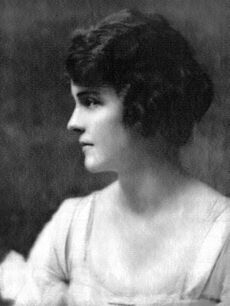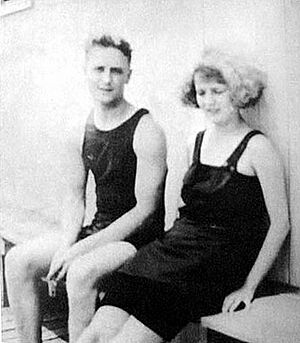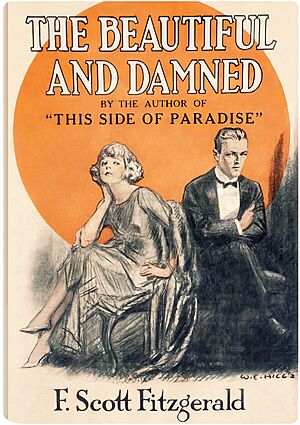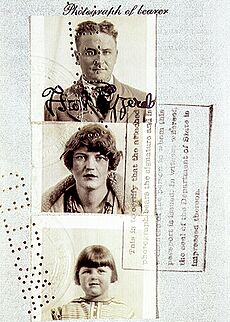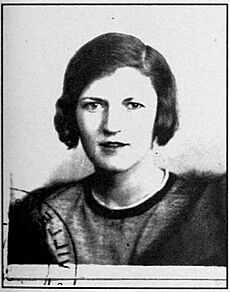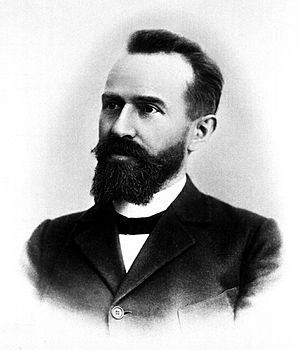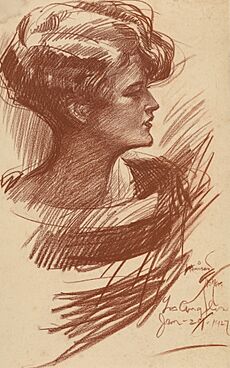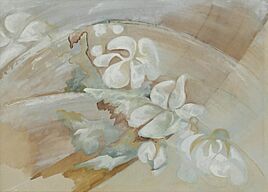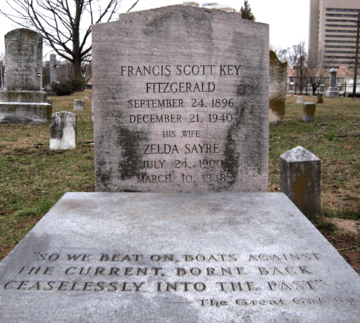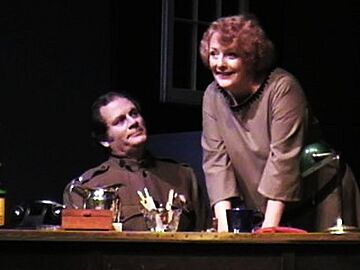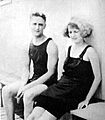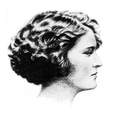Zelda Fitzgerald facts for kids
Quick facts for kids
Zelda Fitzgerald
|
|
|---|---|
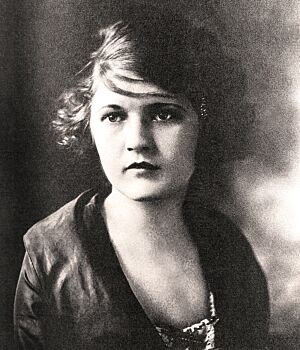
Fitzgerald in February 1920
|
|
| Born | Zelda Sayre July 24, 1900 Montgomery, Alabama, U.S. |
| Died | March 10, 1948 (aged 47) Asheville, North Carolina, U.S. |
| Occupation |
|
| Period | 1920–1948 |
| Spouse | |
| Children | Frances Scott Fitzgerald |
| Relatives | Anthony D. Sayre (father) |
| Signature | |
 |
|
Zelda Fitzgerald (born Zelda Sayre; July 24, 1900 – March 10, 1948) was an American novelist, painter, and socialite. She was born in Montgomery, Alabama, into a wealthy family. Zelda was known for her beauty and lively personality.
In 1920, she married the famous writer F. Scott Fitzgerald. His first novel, This Side of Paradise, made them both very well-known. They became symbols of the exciting "Jazz Age" of the 1920s. Later, Zelda faced challenges with her mental health. Doctors diagnosed her with schizophrenia, though some later experts believe it was bipolar disorder.
While she was in a hospital, Zelda wrote her novel Save Me the Waltz in 1932. This book was partly about her own life in the American South and her marriage. The book did not get good reviews and did not sell well. This made Zelda sad, and she focused more on painting and writing plays. She also tried painting watercolors, but an art show of her work in 1934 was also not very successful.
After her husband died in 1940, Zelda tried to write another novel but did not finish it. She died in a fire at Highland Mental Hospital in Asheville, North Carolina, in 1948. A book about her life by Nancy Milford in 1970 helped people see Zelda's own artistic work in a new way. Her novel and paintings became more appreciated after her death. In 1992, she was honored by being added to the Alabama Women's Hall of Fame.
Contents
- Zelda's Early Life and Family
- How Zelda Met F. Scott Fitzgerald
- Marriage and Becoming Famous
- Pregnancy and Their Daughter, Scottie
- Moving to Europe
- Meeting Ernest Hemingway
- Zelda's Focus on Ballet and Health Challenges
- Writing Save Me the Waltz
- Painting and Later Years
- Hospital Fire and Death
- How Zelda's Work Was Seen Later
- Zelda's Legacy and Influence
- Images for kids
- See also
Zelda's Early Life and Family
Zelda Sayre was born in Montgomery, Alabama, on July 24, 1900. She was the youngest of six children. Her parents were members of the Episcopal Church. Her mother, Minerva Buckner "Minnie" Machen, named her after a character in a novel.
Zelda was a very loved child. Her mother often let her have her way. Her father, Anthony D. Sayre, was an Alabama politician. He was a strict man whom Zelda called a "living fortress." Her family was important and powerful in the Southern states. They had owned slaves before the Civil War.
Zelda's family was part of the "Confederate establishment" in the Deep South. Her grandfather was a Confederate Senator. Her father's uncle, John Tyler Morgan, was a Confederate general. He also helped create the Jim Crow era in Alabama, which kept Black people from voting for many years. Zelda's family even owned the First White House of the Confederacy.
Growing up, Zelda's wealthy family had many servants, including African Americans. Because of this, Zelda did not learn to do housework. She loved to dance and took ballet lessons. She also enjoyed being outdoors. In the summers, her family would visit Saluda, North Carolina. This village later appeared in her artwork. In 1914, Zelda started attending Sidney Lanier High School. She continued her ballet studies there.
How Zelda Met F. Scott Fitzgerald

Zelda Sayre first met F. Scott Fitzgerald in July 1918. They met at the Montgomery Country Club. At this time, Scott was a hopeful writer. He had recently been turned down by his first love, Ginevra King, because he did not have much money.
Scott was sad and had left Princeton University. He joined the United States Army during World War I. He was stationed near Montgomery, Alabama, waiting to go to war. A lonely Scott started to spend time with Zelda. He called her every day and visited Montgomery often. He talked about his dream of becoming a famous writer. He even sent her a chapter of a book he was writing.
Zelda did not think Scott would become a famous writer at first. Scott was very interested in Zelda. He changed a character in his book, The Romantic Egotist, to be like her. He told Zelda that the "heroine does resemble you."
In the early days of their relationship, Zelda and Scott walked through the Confederate Cemetery. Zelda felt very strongly about the history there. Scott later used her feelings about the South in his 1920 short story The Ice Palace.
Scott's love for Zelda grew stronger. He wrote to a friend, "I love her and that's the beginning and end of everything." Zelda also fell in love with him. A writer named Nancy Milford said that Scott saw something special in Zelda. It was a romantic feeling of self-importance, just like his own.
Their time together was stopped in October 1918. Scott was sent north, expecting to go to France. But the war ended, and he returned to the base near Montgomery.
On February 14, 1919, Scott left the military. He moved to New York City to start his writing career. Zelda and Scott wrote many letters to each other. By March 1920, they were engaged to be married. However, Scott's writing career did not take off right away. Zelda worried he could not support her lifestyle. She broke off the engagement in the summer of 1919.
Soon after, Scott returned home to St. Paul, Minnesota. He felt like a failure. He decided to try one last time to become a novelist. He worked day and night to rewrite his book, The Romantic Egotist, into This Side of Paradise. This book was about his years at Princeton.
Marriage and Becoming Famous
By September 1919, Scott finished his first novel, This Side of Paradise. His editor, Maxwell Perkins, decided to publish it. Scott wanted the book released quickly to win Zelda back. He told her about the book's publication. Zelda was surprised and said she had not believed in him at first. She was happy to know he "really can do things."
Zelda agreed to marry Scott once the book was published. Scott promised to bring her to New York. This Side of Paradise came out on March 26, 1920. Zelda arrived in New York on March 30. A few days later, on April 3, 1920, they married in a small ceremony.
Their first years of marriage in New York City were not always easy. But Scott and Zelda quickly became famous. They were seen as the "It" couple of the Jazz Age.
The Fitzgeralds later moved to a small house in Westport, Connecticut. Scott worked on his second novel there. Because Zelda had grown up with many servants, she was not used to doing housework. Scott soon hired maids and a laundress to help.
Zelda's reliance on servants became a funny topic in magazines. When asked for her favorite recipes, she wrote a humorous reply. She said to ask the cook about frying bacon and poaching eggs. She joked that toast burns easily and to be careful with the fire.
While Scott wrote, Zelda missed her home in the Deep South. She especially missed Southern foods like peaches and biscuits. She suggested they travel to Montgomery, Alabama. In July 1920, they drove to her parents' home. After several weeks, they left their car and took a train back to Westport. Zelda's parents visited them, but her father did not like their lifestyle. After this visit, the Fitzgeralds moved to an apartment in New York City.
Pregnancy and Their Daughter, Scottie
In February 1921, Zelda found out she was pregnant. Scott was working on his second novel, The Beautiful and Damned. Zelda wanted their child to be born in Alabama. But Scott strongly refused. Zelda wrote to a friend that Scott had changed. He used to love the South, but now he wanted to be far away from it.
Scott insisted they have the baby in his home state of Minnesota. On October 26, 1921, their daughter, Frances "Scottie" Fitzgerald, was born.
While writing The Beautiful and Damned, Scott used parts of Zelda's diary and letters. He based the main characters on himself and Zelda. Before the book was published, Zelda read it. She asked him to change the ending. When the book came out, a newspaper editor asked Zelda to write a funny review.
Zelda pretended to read the book for the first time in her review. She joked that she recognized parts of her old diary and letters. She wrote, "Mr. Fitzgerald... seems to believe that plagiarism begins at home." She also joked that she hoped the book would sell well. This was so she could buy a "cutest cloth of gold dress for only $300."
This funny review led to other magazines asking Zelda to write stories. Their daughter later said that Scott spent many hours editing the short stories Zelda sold.
Scott's play, The Vegetable, did not do well financially. The Fitzgeralds ended up in debt. Scott wrote many short stories to earn money, but he became tired and sad. In April 1924, they moved to Paris, France. They hoped to live more cheaply in Europe.
Moving to Europe
After arriving in Paris, the family soon moved to Antibes on the French Riviera. Scott worked on his novel The Great Gatsby. Zelda spent her afternoons swimming at the beach. In the evenings, she danced at the casinos.
Scott finished The Great Gatsby in October 1924. The couple tried to celebrate by traveling to Rome and Capri. But they were both unhappy and unwell. While sick, Zelda began painting artworks.
Meeting Ernest Hemingway
When they returned to Paris in April 1925, Zelda met Ernest Hemingway. Her husband, Scott, had helped Hemingway's writing career. Through Hemingway, the Fitzgeralds met other famous writers and artists. Scott and Hemingway became close friends. However, Zelda and Hemingway did not like each other from the start.
Hemingway believed Zelda pushed her husband to write short stories for money. This was instead of focusing on his novels. Scott often wrote stories for magazines like The Saturday Evening Post. Zelda later said she thought stories in The Post were the best. But Scott did not like writing them. He was a very thoughtful writer, she said.
After reading The Great Gatsby, Hemingway promised to help Scott. But he worried that Zelda would harm Scott's career. In December 1926, after two difficult years in Europe, the Fitzgeralds returned to America. But their marriage problems continued.
Zelda's Focus on Ballet and Health Challenges
Much of the trouble between Zelda and Scott came from Zelda feeling bored and alone when Scott was writing. She often interrupted him, and they both became more unhappy. Scott sometimes criticized Zelda, saying great women use their talents well. Zelda deeply wanted to develop a talent that was all her own.
At 28, she became very interested in Russian ballet. She decided to try to become a prima ballerina (a lead dancer). Her friend Gerald Murphy advised her not to. He said there were limits to what a woman her age could do. He felt she had started dancing too late. Even so, Scott Fitzgerald paid for Zelda to train with a ballet director. When they returned to Europe in 1928, Scott paid for her to study with a Russian ballerina in Paris.
In September 1929, a ballet company in Naples invited her to join their school. Zelda practiced for up to eight hours a day. She pushed her body very hard to get better. According to her daughter, Scott encouraged Zelda's talents. But he became worried when her dancing took over her life. It was harming her physical and mental health. Soon after, Zelda became very tired and unwell.
After her physical and mental collapse, Zelda's mental health worsened. She sought psychiatric treatment. She spent over a year in different hospitals. She returned home in September 1931. To keep her out of a hospital, Scott hired nurses to care for Zelda all the time.
Writing Save Me the Waltz
In February 1932, Zelda felt she needed to go back to a mental hospital. As part of her recovery, she spent at least two hours a day writing. By the end of February, Zelda shared parts of her writing with her doctor. The doctor told Scott that the unfinished novel was lively and charming. Zelda sent the manuscript to Scott's editor, Maxwell Perkins.
Perkins was surprised to get a novel from Zelda without warning. He read it carefully. He felt the book had a "slightly deranged quality." He thought it seemed like the author had trouble telling fiction from reality. He believed some parts were good, but the overall style felt old-fashioned. Perkins hoped Scott could help improve it.
When Scott learned Zelda had sent her book to his editor, he was angry. She had not shown it to him first. After reading it, he was upset that her novel used ideas from his own upcoming novel, Tender Is the Night. Zelda wrote to Scott that she was sorry. She was "afraid we might have touched the same material."
Even though Scott was annoyed, he realized Zelda's book could make money. He was in debt. So, he asked for only a few changes. The disagreement was quickly settled. Scott then told Perkins that Zelda's novel was good. He said it was "about something" and new. Perkins agreed to publish it. This also helped Scott pay back money he owed to the publisher.
On October 7, 1932, Save Me the Waltz was published. The book's title came from a record catalog. Zelda said it reminded her of the exciting "Jazz Age" lifestyle she and Scott had. The book was clearly about the Fitzgeralds. The main character, Alabama Beggs, is like Zelda. She marries David Knight, a painter who becomes famous. They live a fast life and move to France. Alabama becomes unhappy in her marriage and focuses on ballet. She becomes a lead dancer but gets sick from exhaustion. The book ends with her returning home to the South.
The novel shows Alabama's struggle to be independent from her husband. She wants to be respected for her own achievements. Zelda's writing style in Save Me the Waltz uses many colorful words and complex comparisons.
However, most literary critics gave Save Me the Waltz negative reviews.
Painting and Later Years
From the mid-1930s, Zelda was often in hospitals for her mental health. She stayed in places in Baltimore, New York, and Asheville, North Carolina.
Even with her health challenges, she kept working on her art. After her novel did not do well, she tried to write a funny play called Scandalabra in 1932. But Broadway producers did not want to produce it. Scott then arranged for a local theater group in Baltimore to stage her play. He spent many hours at rehearsals. Zelda also continued to paint watercolors while in and out of hospitals.
In March 1934, Scott Fitzgerald arranged the first art show of Zelda's work in New York City. It included 13 paintings and 15 drawings. Like her book, her paintings did not get good reviews. The New Yorker magazine simply called them "paintings by the almost mythical Zelda Fitzgerald." The review did not even describe the paintings.
In 1936, Scott placed her in the Highland Mental Hospital in Asheville, North Carolina. Zelda stayed there while Scott went to Hollywood for a job in 1937. For several years, Scott worked in Hollywood and visited Zelda in the hospital. In April 1939, Zelda and Scott took a trip to Cuba. The trip was difficult. They never saw each other again after that trip.
Scott returned to Hollywood to pay for Zelda's hospital bills. Zelda made some progress in Asheville. In March 1940, she was allowed to go home to her mother. She was almost 40 years old. Her friends were gone, and the Fitzgeralds did not have much money. They wrote to each other often and planned to meet in December 1940. But Scott died at age 44 in December 1940, so they never met again.
After Scott's death, Zelda read his unfinished novel, The Love of the Last Tycoon. She wrote to his friend Edmund Wilson, who agreed to edit the book. Zelda believed Scott's work showed a strong American spirit and a "will-to-survive." After reading it, Zelda started a new novel, Caesar's Things. By August 1943, she returned to Highland Hospital. She worked on her novel while going in and out of the hospital. She did not get better and did not finish the novel.
Hospital Fire and Death
Towards the end of her life, Zelda lived in and out of hospitals. She checked back into the hospital in September 1946. Then she returned to live with her mother in Alabama.
In November 1947, Zelda returned to Highland Mental Hospital in Asheville, North Carolina, for the last time. On the night of March 10, 1948, a fire started in the hospital kitchen. Nine women, including Zelda, died in the fire.
Zelda and Scott are buried together in Rockville, Maryland. Their tombstone has the last sentence from The Great Gatsby: "So we beat on, boats against the current, borne back ceaselessly into the past."
How Zelda's Work Was Seen Later
When Scott Fitzgerald died in 1940, he believed he was a failed writer. Two years later, during World War II, his book The Great Gatsby became very popular with American soldiers. By 1944, people were very interested in Scott's work again. However, Zelda's death in 1948 was not widely reported in the news.
In 1970, a book called Zelda: A Biography by Nancy Milford changed how people saw Zelda and Scott's marriage. This was the first full book about Zelda's life. It became a very popular book. The book showed Zelda as an artist in her own right. It suggested that her talents were not fully appreciated by her husband. Zelda became a symbol for the feminist movement in the 1970s. She was seen as a woman whose potential was held back by society.
After Milford's book, people started to look at Zelda's own writing differently. Before, some scholars thought her novel Save Me the Waltz was only worth reading because it helped understand F. Scott Fitzgerald. But after Milford's book, a new view appeared. Scholars said Save Me the Waltz was a powerful and interesting novel that should be read for its own value. People began to study her novel to see how it differed from Scott's story of their marriage in Tender Is the Night. They also looked at how the consumer culture of the 1920s affected women.
In 1991, Zelda's collected writings, including Save Me the Waltz, were published. A critic from The New York Times said it was amazing that the novel was written in two months. She added that even with its flaws, it was charming and moving. Zelda Fitzgerald succeeded in showing her "heroic desperation" to achieve something of her own. She also showed herself to be a writer with a gift for making language "iridescent and surprising."
Zelda's artwork also gained new attention. Many of her paintings had been stored away or even burned by her mother. But scholars became interested in them again. Art shows of her watercolors have been held in the United States and Europe. A review of one show noted the influence of artists like Vincent van Gogh and Georgia O'Keeffe on her paintings. It said her art showed the work of a talented woman who overcame many challenges.
Scholars still discuss how Zelda and Scott influenced each other's creativity. Zelda's daughter, Scottie Fitzgerald, said that her father encouraged Zelda's talents. She said he arranged her first art show in New York. He also sat through many rehearsals of her play, Scandalabra. And he spent hours editing the short stories she sold to magazines.
Zelda's Legacy and Influence
Zelda's life inspired the song "Witchy Woman" by the Eagles. The band's member, Don Henley, read Zelda's biography. He saw her as the wild, charming, and important "flapper" of the Jazz Age.
Zelda's name also inspired Princess Zelda, a character in The Legend of Zelda video games. In 1989, the F. Scott and Zelda Fitzgerald museum opened in Montgomery, Alabama. It is in a house they rented for a short time. It is one of the few places where some of Zelda's paintings are on display.
In 1992, Zelda and her daughter Scottie were added to the Alabama Women's Hall of Fame.
In 2023, there were plans for three new hotels in Asheville, North Carolina. Two of them will have themes based on Zelda Fitzgerald. "Zelda Dearest" will have 20 rooms and show the "beauty and optimism" of Zelda's early life. "Zelda Salon" will have 35 rooms. Its design will be based on where the Fitzgeralds stayed in the 1920s.
Images for kids
See also
 In Spanish: Zelda Fitzgerald para niños
In Spanish: Zelda Fitzgerald para niños


